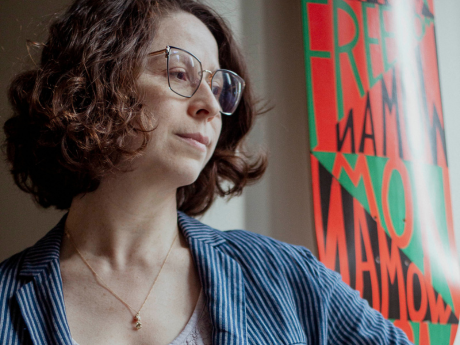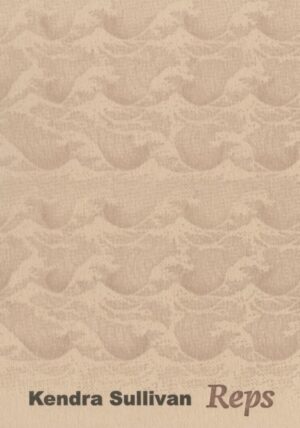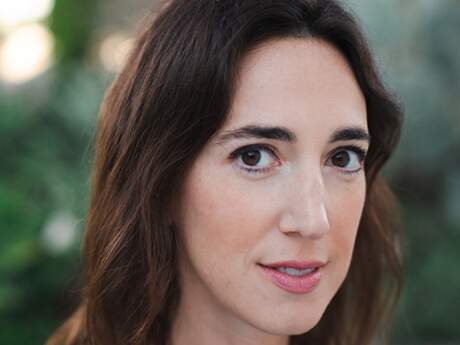In Their Own Words
Kendra Sullivan on “Ana”

A story about a waterbirth
A story about the ways water is not
exactly its location, source, or destination
not its surface, depth, or volume
not its contents or a tissue stretched
between continents
A story about how water exceeds identification
how its soul is “circulation”
A story about vital needs being ignored by nuns
A story about crowning in a toilet
A story about a family forged at a crowning
A story about being sovereign not royal
A story about bypassing the crown
of circular narrative by marrying the church
A story about how an institution
cannot reproduce biological life
A story about how institutions can and do
reproduce bare life
A story about how the museum
as an institution is always
about itself (William Pope L.)
A story about a nun
and another single mother named Pilar
A story about a midnight waterbirth
in a convent bathroom
A story about the nuns’ habits gathering like damp
curtain swag beneath the bathroom stalls
A story about the preponderance
of blood–the afterbirth that gladdens
the paving stones by the drain
A story about a dried caul
to protect against (dry) drowning
A story about birthing coworkers
A story about a vocation
a calling
A story about a convent education
A story about the contents of convents
subduing the heart
or its heat, about the arterial sounds
of rushing water in a rusted pipe
about crocheting pillow covers to smother
the needling question of so many remains
A story about children
A story about what makes some nuns
such hardy bursars
of so many small burials?
A story about the role of unwed women
in colonialist expansion
A story about who can counter nunwork
if not mothers
A story about how nuns make it hard
but moms make it work
A story about how moms who don’t have help
help each other out
help themselves
A story about being a child eating dinner
late at night in another’s mother’s kitchen
A story about neighbors raising
my mother’s child–me
A story about Patricia Hill Collins’
othermothering, about accepting
the fundamental workability
of asymmetrical love
that it doesn’t have to be reciprocal
or nothing
A story about sleep
is like water
a dream of misidentification
with the self
a hatch is another
word for a passage is…
A story about an earlier, ongoing pandemic
A story about how my mom
gave birth to navel genres
submerged her story
in a sub-sub genre
she called “crush depth”
A story about how “passage”
is another word for para
graph beings and ends with a break
in sense, because submarines
also breach
when they go too deep
A story about asking future generations
how to soften the blows
A story about ceding power
so we can heal
A story about the way male
seahorses carry a couple thousand
babies in their abdominal pouches
A story about how some bodies give birth
and take life with abandon
without recourse
A story about how queer
nature is
A story about the way floating suspends
storyforms
like location, migration, and belonging
A story about how motile we become after birth
cruising straight down
into “crush depth”
Reprinted from REPS (Ugly Duckling Presse, 2024) with the permission of the author. All rights reserved.
On "Ana"
I grew up on a great marsh. During full moon tides, waves lapped the door sill at the back steps and salt spray lashed the bedroom windows where I slept. Being young and green next to something as old and deep as the sea shaped me as a person and a poet, in much the same way the waves shaped the near shore—slowly over time—and then suddenly, all at once.
My friend Mark, a sedimentologist, once called historic weather events “geologic clock accelerators.” We were standing on a bluff next to a gray hut where a volunteer was counting waves to estimate erosion rates. I was seven months pregnant, winded after the brief, steep walk to the top. A bad storm had precipitated six feet of shoreline loss overnight. When it comes to coastal attrition, he said, the less ground there is, the more rapidly it calves into the sea. In the same way, climate change speeds up and winds down the time left on Earth’s atomic clock. While catching my breath on the clifftop of new life, I wondered what to make of all this quickening.
New research findings suggest that pregnancy increases the epigenetic age of the birthing parent. However, the researchers were surprised to learn that at three months postpartum, many new mothers had demonstrably reversed the aging process.[1] Still other studies suggest that biological pregnancy is a time of neuronal growth and connection—a regenerative window of increased “plasticity” akin to infancy or puberty.[2] Might we reconcile these particular contradictions by saying that as long as the pace of learning roughly corresponds to the pace of change, however rapid and whatever the catalyst, resilience, adaptation, and recovery remain possible?[3] And how might this hypothesis apply to just transition?
Reps is my first full length book of poetry and its title gestures toward repetition, representation, and reproduction—in all its valances, including social, institutional, and biological. But the title also nods to strength training because such training suggests to me a daily ritual undertaken to prepare for a trial or a test. Reps gathers several “exercises” that helped prepare me–intellectually, conceptually, ethically–to show up for my child as a parent in the age of climate chaos.[4]
“Ana” is from Typologies of Possible Biographies, the second exercise in Reps. A spiraling accretion of one-liners derived from deep listening and oral history, Typologies builds on the anaphora “a story about,” much the same way Joe Brainard builds on “I remember.” The central thesis of Typologies
is that people are neither autonomous nor separate selves, and the art (or arc or ark) of storytelling can be remixed via poetic intervention to glimpse or grok fuller, more complex identities (complex, meaning, made of many different, connected parts). Thematically, “Ana” addresses three preoccupations of mine (and the book’s): Earth, birth, and the sea.
To write Typologies, I developed a method of composition I called “wave action.” In geologic terms, wave action encompasses the cumulative processes by which the crashing waves shape the land over time. Wave action in nature puts creation and decreation in continuous exchange. In methodological terms, wave action allowed me to build momentum and meaning through circularity, recursivity, and repetition. The poems exist on a formal continuum that includes the list poem, incantation, and the lyric, with its explicit intention to locate the whole, wholly expressed, in each of its component parts. Similarly, in Typologies, I remix intimate stories shared with me by friends to uncover the collective in the individual and recover the individual in the collective through a poetics of counter-narrativity.
Tibetan bodhisattva of compassion, Avalokiteśvara, is said to have described waves as “empty of a separate self.” Reps is a love letter to waves in all their shapes, shades, and transfigurations—at once immutable and unstable; apparently impregnable but also wholly vulnerable to human maleficence; the seat of life and the unmarked site of a mass grave. Waves. The power of their collective repetition (and difference) is so beautifully illuminated by interior designer Serena Solin, who crafted the wave emoji that demarcates section breaks; artist KB Jones, who drew the cover art; and poet-printmaker Milo Whippermann, who designed and printed the cover of the book; and the many friends reflected and refracted inside.
[1]Pham H, Thompson-Felix T, Czamara D, Rasmussen JM, Lombroso A, Entringer S, Binder EB, Wadhwa PD, Buss C, O'Donnell KJ. The effects of pregnancy, its progression, and its cessation on human (maternal) biological aging. Cell Metab. 2024 May 7;36(5):877-878. doi: 10.1016/j.cmet.2024.02.016. Epub 2024 Mar 22. PMID: 38521058.
[2] Carmona S, Martínez-García M, Paternina-Die M, Barba-Müller E, Wierenga LM, Alemán-Gómez Y, Pretus C, Marcos-Vidal L, Beumala L, Cortizo R, Pozzobon C, Picado M, Lucco F, García-García D, Soliva JC, Tobeña A, Peper JS, Crone EA, Ballesteros A, Vilarroya O, Desco M, Hoekzema E. Pregnancy and adolescence entail similar neuroanatomical adaptations: A comparative analysis of cerebral morphometric changes. Hum Brain Mapp. 2019 May; 40(7):2143-2152. doi: 10.1002/hbm.24513. Epub 2019 Jan 20. PMID: 30663172; PMCID: PMC6865685.
[3] To my knowledge, these studies don’t yet adequately account for social factors including chronic poverty-induced stress, systemic and medical racism, social isolation, lack of affordable childcare, or the difficulties of navigating maternal care in private sector hospital systems. Research is evolving.
[4] “My child” here is shorthand for any child. “Any child” here is shorthand for every human. “Every human” here is shorthand for all beings alive to nature, culture, or the cosmos, now and in the future, no exceptions.



